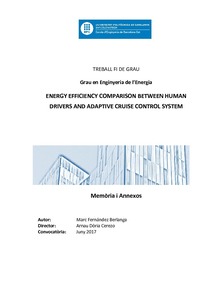Mostra el registre d'ítem simple
Energy efficiency comparison between human drivers and adaptive cruise control system
| dc.contributor | Dòria Cerezo, Arnau |
| dc.contributor.author | Fernández Berlanga, Marc |
| dc.date.accessioned | 2018-03-09T13:12:51Z |
| dc.date.available | 2018-03-09T13:12:51Z |
| dc.date.issued | 2017-06 |
| dc.identifier.uri | http://hdl.handle.net/2117/115008 |
| dc.description.abstract | In this project, a mathematical model implemented in MATLAB-Simulink has been developed with the aim of studying how vehicles behave in different traffic scenarios, not only in fluidity terms but also in energetic consumption. The study mainly focuses on the incorporation into roads of vehicles with ACC (Adaptive Cruise Control), vehicles that regulate their speed automatically to avoid colliding with the vehicle in front, always keeping a safety distance. Some simulations with different number of vehicles of this type have been carried out in order to find out how the impact on traffic fluidity and average energy consumption is. In the project report, the model developed to perform simulations is explained and results are shown, as well as an appraisal about benefits for traffic and energy savings that the incorporation of vehicles with ACC involves. |
| dc.language.iso | eng |
| dc.publisher | Universitat Politècnica de Catalunya |
| dc.rights | Attribution-NonCommercial-ShareAlike 3.0 Spain |
| dc.rights.uri | http://creativecommons.org/licenses/by-nc-sa/3.0/es/ |
| dc.subject | Àrees temàtiques de la UPC::Enginyeria mecànica |
| dc.subject.lcsh | Automobiles--Energy consumption |
| dc.title | Energy efficiency comparison between human drivers and adaptive cruise control system |
| dc.type | Bachelor thesis |
| dc.subject.lemac | Automòbils -- Aspectes ambientals |
| dc.subject.lemac | Automòbils -- Contaminació |
| dc.rights.access | Open Access |
| dc.audience.educationlevel | Grau |
| dc.audience.mediator | Escola d'Enginyeria de Barcelona Est |
| dc.audience.degree | GRAU EN ENGINYERIA DE L'ENERGIA (Pla 2009) |
| dc.contributor.covenantee | TERSA Tractament i Selecció de Residus |


